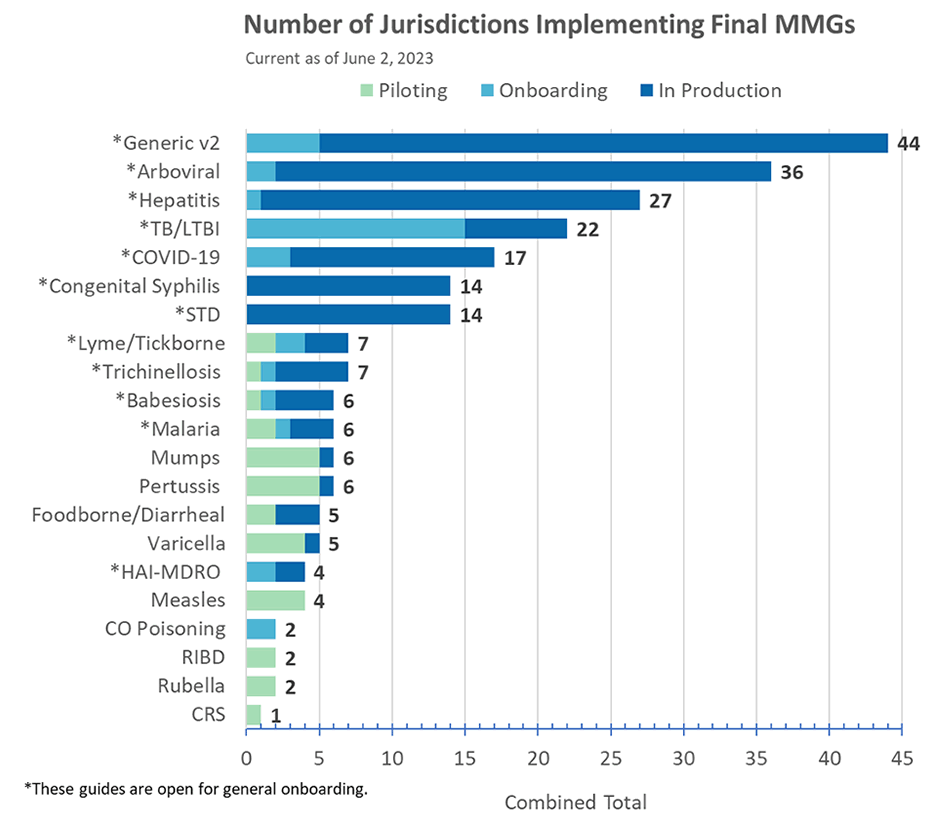June 2023
June 25–29, 2023: Council of State and Territorial Epidemiologists (CSTE) 2023 Annual Conference in Salt Lake City, UT. Register for the conference.
July 18, 2023, 3:00–4:00 PM ET: Monthly eSHARE training webinar: "Highlights from the 2023 Council of State and Territorial Epidemiologists (CSTE) Annual Conference."
Last Friday of each month, 1:00–2:00 PM ET: Monthly CSTE Data Standardization Work Group meetings. Join the CSTE Data Standardization Work Group.
CDC offices to partner for flexible case data exchange

As part of CDC’s Public Health Data Strategy, CDC’s Office of Public Health Data, Surveillance, and Technology (OPHDST) and Office of the Chief Information Officer (OCIO) are collaborating to offer jurisdictions more flexibility in how they send their case data to CDC through the National Notifiable Diseases Surveillance System (NNDSS).
In the modern vision of CDC’s Front Door, CDC will offer jurisdictions a single point of entry to submit NNDSS case data to CDC through the Enterprise Data Exchange (DEX) platform, regardless of the format in which data are sent. Once CDC receives case data through DEX, the Message Validation, Processing, and Provisioning System (MVPS) will validate, process, analyze, and provide these data to CDC programs.
CDC also plans to leverage EpiSync, a new approach being developed for public health jurisdictions to transmit information as tables to CDC, as part of DEX. This means jurisdictions would have the option of sending their case data to CDC in a CSV format, in addition to the current HL7® format.
CDC is offering CSV as an alternative format to HL7 to meet the needs of all jurisdictions. However, CDC recognizes that many jurisdictions have invested significant effort into developing HL7 expertise and onboarding HL7-based Message Mapping Guides (MMGs). CDC will continue to receive HL7 data from jurisdictions who prefer to use this format.
CDC will continue to provide regular updates on various efforts currently underway, including MVPS modernization, NBS modernization, EpiSync, electronic case reporting, related pilots, and more. CDC will provide updates through our regular communication channels, such as Case Surveillance News, the eSHARE webinar series, and CDC’s Frequently Asked Questions: Case Surveillance Modernization webpage.
CDC held an eSHARE training webinar, titled “CDC’s Office of Public Health Data, Surveillance, and Technology: Updates on Case Surveillance Modernization” on June 20, 2023. This webinar offered jurisdictions the opportunity to learn more about CDC’s plans to make case data exchange more flexible.
Access the slides and recording in the eSHARE archive. CDC posts these materials soon after each webinar.
If you have questions or input for CDC, please use the NNDSS jurisdiction feedback form.
CDC publishes 2020 annual NNDSS infectious disease data

CDC has posted annual infectious disease data tables for 2020 on CDC WONDER. These tables provide detailed information about cases of infectious disease sent by state, local, and territorial jurisdictions to CDC using the National Notifiable Diseases Surveillance System (NNDSS).
Users can access the NNDSS annual data tables on CDC WONDER from the data and statistics section of the NNDSS website. In addition, CDC offers these data in an interactive view of NNDSS annual data.
Table 1 displays reported infectious notifiable disease case counts and rates for the United States overall.
Tables 2a–2t display reported infectious notifiable disease case counts for specific U.S. states and territories.
CDC has added a new “Reporting Area” category to Tables 2a–2t. Beginning with the 2020 annual tables, reported cases among non-U.S. residents are displayed in a separate row in Table 2.
Cases are assigned to a “Reporting Area” based on the country of usual residence (COUR) algorithm.
- If the case’s country of usual residence is the United States, a U.S. territory, unknown, or country is not reported, the case is assigned to the reporting jurisdiction submitting the case to NNDSS.
- Cases that do not meet the criteria above are assigned to the Non-U.S. Residents’ category.
Some jurisdictions do not report the COUR data element or do not report it for all conditions. This is because the COUR data element is only available in the HL7 generic version 2 (GenV2) and disease-specific message mapping guides. Jurisdictions are not able to send this information in legacy case notification formats.
Table 2 stratifies data into four categories based upon the COUR algorithm:
- S. residents, excluding U.S. territories;
- S. territories;
- Non-U.S. residents; and
- Total.
Table 3 displays reported infectious notifiable disease cases by month for the United States overall.
Tables 4–7 display reported infectious notifiable disease case counts and rates by age group, sex, race, and ethnicity for the United States overall.
Table 8 displays the total resident population and population by age subgroups by reporting area. Reporting areas include the United States overall and Health and Human Services region, state, and territory. This information provides a reference for population denominators used in rate calculations.
The list of national notifiable diseases and case definitions for 2020 is available on the NNDSS website.
CDC’s NNDSS team would like to thank jurisdictions and CDC disease programs for supporting NNDSS during reconciliation and publication of the 2020 annual tables.
CDC develops quarterly roadmap for NBS modernization

CDC is redesigning the National Electronic Disease Surveillance System Base System (NBS) to meet current and future public health needs and strengthen state, local, territorial, and tribal (STLT) surveillance infrastructure. As part of NBS’s modernization effort, the team has developed a quarterly roadmap to communicate future progress, milestones, and major outcomes.
Read the NBS modernization roadmap.
The roadmap will serve as a guide to help developers and target audiences understand:
- How modernization strengthens an interconnected data system
- The iterative and agile change process for new features and updates
- NBS’s approach to building a state-of-the-art integrated disease surveillance system.
To better align with CDC’s new direction for NBS, the NBS team recently transitioned from a 6/12/24-month approach to a more flexible quarterly planning schedule to ensure the best outcomes for the project.
The new planning schedule allows CDC to engage with jurisdictions and users more frequently to integrate jurisdiction feedback into the new product development lifecycle. The feedback from jurisdictions and lessons learned in the previous quarter may impact revisions made to the roadmap during the next quarter.
Visit and bookmark CDC’s NBS modernization webpage to learn more about CDC’s vision and approach for NBS modernization and get monthly project updates.
Want to create the future of case surveillance?
CDC and the CSTE Data Standardization Work Group need your help to make case surveillance more efficient by standardizing data across the case surveillance ecosystem.
CSTE holds meetings of the Data Standardization Work Group the last Friday of each month at 1:00 PM ET.
CDC held an eSHARE webinar, titled “CDC’s Office of Public Health Data, Surveillance, and Technology: Updates on Case Surveillance Modernization” on June 20, 2023. Access the slides and recording in the eSHARE archive. CDC posts these materials soon after each webinar.
CDC will hold the next eSHARE webinar, titled “Highlights from the 2023 Council of State and Territorial Epidemiologists (CSTE) Annual Conference,” on July 18, 2023, 3:00–4:00 PM ET.
To join an eSHARE webinar, please see your calendar invitation or contact edx@cdc.gov for login information with the subject line “eSHARE invitation.”
Although CDC has paused most message mapping guide (MMG) development and onboarding efforts as part of modernizing case surveillance, we encourage jurisdictions to implement and onboard the generic version 2 (GenV2) and Tuberculosis/Latent Tuberculosis Infection (TB/LTBI) MMGs.
In May 2023, CDC emailed NNDSS jurisdictions customized guidance on which condition-specific guides will continue to receive onboarding support during the pause. To develop customized guidance, CDC used each jurisdiction’s current onboarding status and criteria for continued support during the pause. Learn more about support for MMG onboarding during the pause and get answers to other frequently asked questions about case surveillance modernization.
HAI MDRO MMG
The PHIN Vocabulary Access and Distribution System (VADS) Healthcare-Associated Infections (HAI), Multidrug-Resistant Organisms (MDRO) Case Notification View Version 4 is now available for the HAI MDRO MMG version 1.0.2. The changes include:
- 2 values added to auris (now v.2).
- 2 values added to PHVS_LabTestType_CP-CRE (now v.2).
- 4 values added to PHVS_LabTestMethod_MDRO (now v.3).
- 16 values added and 5 deprecated for PHVS_GeneName_CP-CRE (now v.4).
- 76 values added and 2 deprecated for PHVS_Organism_CP-CRE (now v.3).
Congratulations to the following jurisdictions for being in production as of June 2!
- Alabama for COVID-19 MMG
- Kentucky for Babesia, Trichinellosis, and Lyme/TBRD MMGs
- Rhode Island for STD/CS MMGs
- Idaho for TB/LTBI MMGs
Reminder: Name change for NETSS year-to-date folder
On June 15, 2023, the CDC NNDSS team updated the name of the folders where jurisdictions using the National Electronic Telecommunications Surveillance System (NETSS) record layout upload their year-to-date (YTD) files for processing.
The “YTD” folders are found within the “NETSS EPI upload,” “NETSS STD upload,” and “NETSS VPD upload” directories in the CDC Secure Access Management System (SAMS). CDC renamed the “YTD” folders in each of these directories to “CAUTION_YTD_FULL_Year_Files_Only.” Jurisdictions can view these directories based on their assigned permissions for uploading NETSS files.
The new name helps distinguish the folder for YTD data files from the folders for weekly data files. This change helps jurisdictions avoid unintentionally deleting cases by uploading weekly data files into the “YTD” folders.
Learn more about NETSS YTD file processing in the help section of the Message Validation, Processing, and Provisioning System (MVPS). This link requires MVPS access to view.
Spotlight: NNDSS at the 2023 CSTE Annual Conference
CSTE will hold its annual conference on June 25–29, 2023. The conference connects public health epidemiologists from across the country to share best practices.
Mark your calendars for the following presentations to get important updates and insights about NNDSS! All presentations and posters listed below are in the surveillance/informatics track.
Visualizing Case Surveillance and Emergency Department Data to Support the National 2022 Mpox Public Health Emergency Response, May–December 2022
- Format: Oral presentation
- Presenting: Shannon Kindilien, CDC Case Surveillance Operations Team
- Monday, June 26, 3:45−5:00 PM MT
National Notifiable Diseases Surveillance System (NNDSS) Progress and Future Directions
- Format: Oral Presentation
- Presenting: Sara Johnston, NNDSS Program Lead
- Tuesday, June 27, 3:45−5:00 PM MT
Moving Towards Standardized Data Elements for Case Surveillance
- Format: In-person roundtable
- Presenting: Danielle Tack and Amanda Jones, CDC Data Standardization and Assistance Team
- Wednesday, June 28, 12:45−1:30 PM MT




